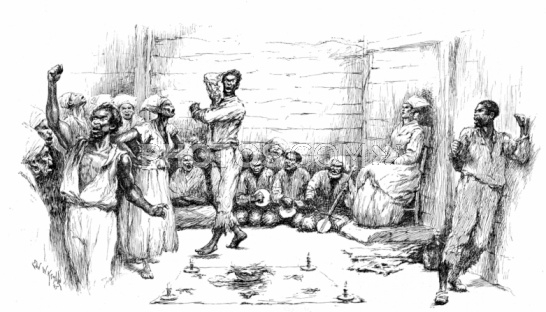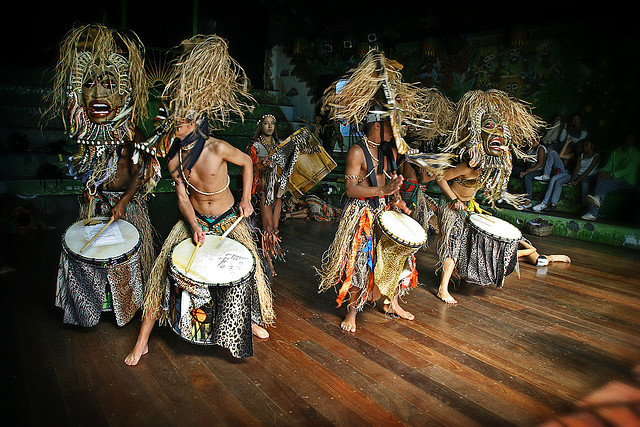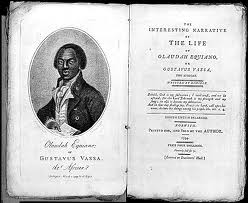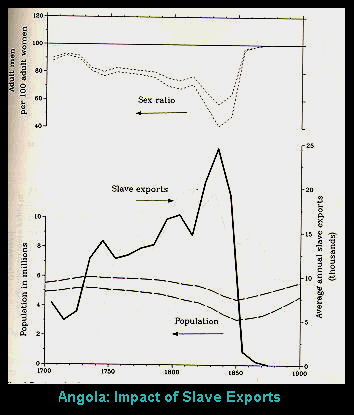Effects and Developments of the Forced Migration of Africans
4.2.3 By Anna Dengler
Europe & New WorldThough the effect on Africa due to the slave trade was very negative, in the Americas it was the exact opposite. As population decreased in Africa, it increased in the Americas. Even today, approximately one tenth of our population can trace its roots back to an imported slave. The demographic effects of the slave trade varied on the area. In the British West Indies, for example, the proportion of people descendent from slaves in eve greater, since more slaves were needed in this area. Slaves went wherever they were needed, so the distribution of slaves throughout the New World is directly related to slavery. Even after slavery was abolished, most slaves were left without the necessary resources to sustain on their own, and were therefore unable to move to improve their conditions, some even wound up working for their previous masters, often under the same conditions that they endured as slaves. The slave trade also resulted in a variety of racial mixing. A growth of individuals who were not purely African, Europeans or Native American increased.
Economically, the slave trade was very profitable to the New World and Europe. Slavery in the Americas can be linked to many things that helped shape Europe today, such as industrialism, Capitalism, the scientific revolution, major migrations, a population boom, and changing social roles. One example being that the British textile exports to Africa, in order to pay for slaves, was a factor which led to the British industrialization. Europe prospered greatly through the slave trade, gaining new crops, such as sugar at no expenses other than having to initially pay for the slave. Europe was able to prosper through new crops and resources they imported from America. As Europe was economically thriving, the exact opposite was happening to Africa. Not only did the slave trade impact Europe and the New World demographically and economically, but also culturally. One of the major cultural influences that the slaves had on the New World was a religious influence, more so on the Caribbean, Haiti and Cuba than on the Americas. The religious interaction between African practices and traditions and Christianity in the New World formed a new unique mixture of belief. The effect was even greater on the Caribbean, where the African use of minkisi, or charms used in healing, and the Catholic use of oils and holy water combined to form what is modernly known as voodoo. Even some ancient African beliefs are still present in places like Cuba. African religion proved to be very strong and consistent. For example, slave owners tried to rid their slaves of their native practices by separating them from one another and buying slaves who do not speak the same languages, however, some ancient African religions are still present today, verifying that Africans had a strong belief system and influenced some of the belief systems today through that. Some slave owners wanted their slaves to convert to their religion, such as Christianity, in order to increase obedience and work efforts; however, this backfired when slaves were becoming more educated in the religious aspects, and started fusing their own religion with the European religions and started bonding through this. The formation of an individualistic religion that was only practiced amongst those slaves was one of the reasons slaves later decided to rebel, and even early signs of rebellion, such as secret meetings at night between different slaves to practice religion, were found as soon as some European slave owners decided to teach some of their religious beliefs to their slaves. Music was another African cultural aspect that influences America today. Slaves were very fond of their native music and practiced it very frequently when forced to work, not only alone, but with other slaves as well. Singing and the drums were the main instruments used. Some of these Native African chants made their ways into South America, where local musicians picked them up and incorporated them into their own music, forming what is modernly known as the Argentine tango of the Dominican merengue. This music was very consistently practiced by slaves throughout time and was later adapted by Harlem Renaissance activists, which further inspired the African Americans to revolt and fight for their equal rights. Music was ultimately another factor that eventually led to the African American freedom, and not only inspired African Americans, but modern white musicians as well. As time advanced and slaves began to gain their freedom and some literacy, the stories about slavery and the orally passed on storied began to be put down in writing. Some of these narratives and stories were very brutal and socking, such as the writings of a slave named Olaudah Equiano, who described the brutality and unjustness in slavery and the ways slave owners treated their slaves. One of his excerpts states “I was often a witness to cruelties of every kind, which were exercised on my unhappy fellow slaves. I used frequently to have different cargoes of new Negroes in my care for sale; and it was almost a constant practice with our clerks, and other whites, to commit violent depredations on the chastity of the female slaves; and these I was, though with reluctance, obliged to submit to at all times, being unable to help them.” It were these early writings by slaves and even free African Americans that helped inspire all blacks to years for equal freedom and actually do something about it. Along with religion and music, African pieces of writing helped contribute to the slaves ‘mission’ to acquire freedom and equality. Not only did it do that, but these literary pieces also inspired white authors, especially women who identify with the powerlessness of the slaves. These inspirations led to some of the great works of literature that we have today, such as the book The Color Purple, and is taught in our very classrooms today, shaping our education and ways of thinking. Besides the obvious effects of a boom in economy, the European rise in power and the eventual Civil War, leading to the African American freedom in the New World, the trans-Atlantic slave trade had a lot of other effects on our modern day practices, such as religion and music and literature. |
|
AfricaThe effects the slave trade had on Africa was very extreme, and still lingers today. Due to so many males being exported as slaves for the Europeans use in the New World, marriage patterns shifted greatly, and the male to female ratio was very skewed and the number of marriageable men decreased in many African nations. All throughout Africa, populations lost numbers, remained at a constant or had very little growth due to this disproportion between men and women. Fewer men to help reproduce and work meant a slower economic growth, if any at all. This effect played out greatly in the Upper New Guinea coast, in which the slave exports were so severe; population growth stopped up until the early nineteenth century. Africans selling their own people for the slave trade often led to heightened effects of diseases, famine or natural disasters. In place such as New Guinea, famine was a major problem, since the loss in male population meant less males who were able to produce food leading to a higher death rate and an even greater loss in population. African villages were also often forced to interact with one another because of the migration of slaves. This interaction led to a greater spread of diseases from one African village to another which caused even more of a population decrease. One of the regions which lost a great amount of population through this disease spread was Angola. The slave trade turned out to have severe effects on the population of Africa even today. Around 1600, the population of Africa was estimated to be around thirty percent of the combine population of Europe, the Americas, the Middle East and Africa. Today it is only about ten percent.
The Economic impact of the slave trade on Africa was also very severe. Africans originally exchanged their slaves for good such as money, firearms, alcohol, iron goods and textiles. These good usually went straight to the kings of the African nations, but were found present amongst the commoners as well. This exchange provided short-term wealth, but turned out to be devastating to Africa in the long run. Rather than focusing on creating their own wealth and goods which would be trade worthy with Europe and other nations, Africa relied on the slave trade to sustain as nation as a whole. Once slavery was abolished, the Africans had no more goods to trade with the Europeans in return for money, which led the disruption of kingdoms running smoothly and healthily, since they depended on those imports to sustain. This led to a major setback of the African villages, since they now were unable to sell slaves for goods needed to sustain, and were incapable of producing goods which would be worthy enough for the Europeans to trade due to their loss of male population who could harvest these goods or invent such goods. |




